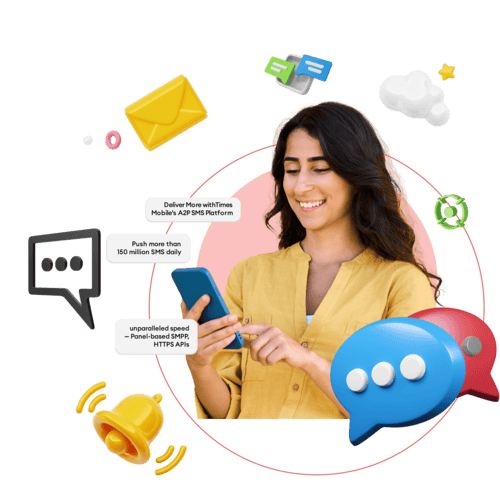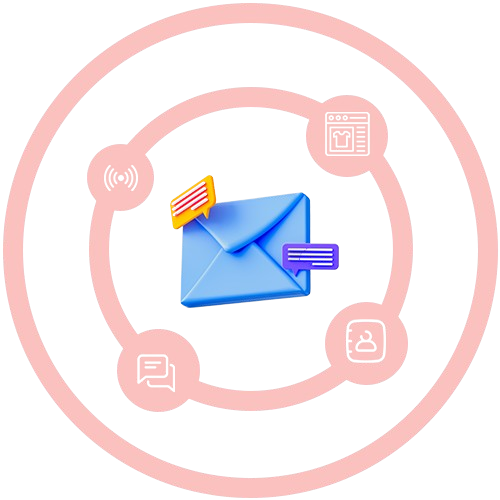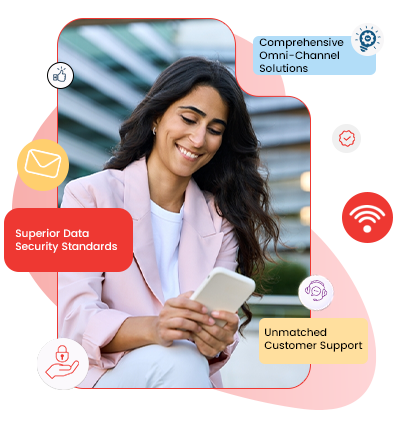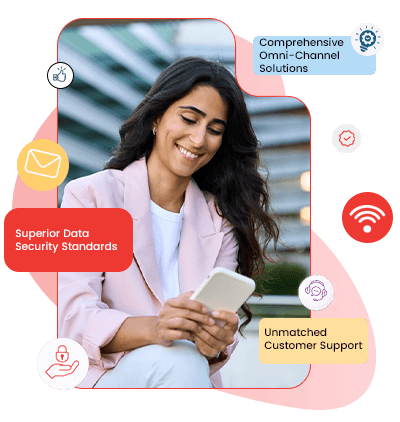Measurable Impact with Every SMS Sent
Seamless Integrations for Smarter Bulk Messaging
Our sms messaging service easily connects with leading CRM, marketing automation, and analytics platforms like WebEngage, MoEngage, CleverTap, and Zoho. This ensures your campaigns are triggered automatically, messages are personalized at scale, and delivery insights flow directly into your existing workflow—helping you achieve faster response times and higher engagement.





Purpose-Driven
A2P SMS for
Maximum Impact
Designed to support large-scale messaging, our SMS service integrates smoothly with your existing infrastructure, ensuring reliable delivery across all networks. As a trusted SMS gateway provider, we ensure your messaging campaigns are both effective and compliant. Make your messaging campaigns effective and secure with our bulk messaging service and solutions from top SMS platform providers.
Our Bulk SMS Service Features

Transactional Alerts

Segment & Retarget


Promotional Messages

Loyalty Programs
Maximize the impact and return on investment of your bulk SMS campaigns by following these proven strategies for effective mobile communication.
Our platform provides the tools you need to not only send messages but to create intelligent, data-driven campaigns that resonate with your audience and drive measurable results for your business.
Segment Your Audience
Group contacts based on behavior or demographics to send highly relevant and targeted messages that boost your overall engagement.
Personalize Your Message
Use merge tags to include customer names or other data, making your bulk campaigns feel like a one-to-one, personalized conversation.
Include a Clear CTA
Drive action by including a clear call-to-action with a shortened link, prompting users to visit your site or redeem an offer.
Track Your Performance
Use our real-time analytics dashboard to monitor delivery rates, click-throughs, and campaign performance to optimize future sends.
Why Choose Times Mobile as Your Bulk SMS Provider?
High-Speed Delivery Network
Our direct telecom operator connections ensure your high-volume campaigns are delivered in seconds, not minutes, maximizing timeliness and impact.
Robust & Scalable Platform
Built to handle over 4 billion messages monthly, our auto-scaled infrastructure guarantees reliable performance for sends of any size.
Expert DLT Compliance
As a leading bulk SMS service provider, we help you navigate TRAI regulations with ease through built-in DLT support and expert guidance.
Frequently Asked Questions (FAQs)
DLT, or Distributed Ledger Technology, is a blockchain-based registration system mandated by TRAI to combat unsolicited communication. Yes, it is mandatory for any business using a bulk SMS service in India. The process involves registering your business, headers (Sender IDs), and content templates on a DLT platform. This ensures all communication is verified, building trust and improving the messaging ecosystem. Our platform is fully integrated with DLT requirements, and our team provides expert guidance to help you complete the entire registration process smoothly.
A Sender ID, now a “Header” under DLT, is the name or number that identifies who sent the SMS. Promotional messages use a 6-digit numeric code, while transactional messages can use a 6-character alphabetic code reflecting your brand. To get one approved, you must register your business on a DLT platform. Once verified, you can submit your desired Headers. As an experienced bulk message provider, we assist you in this process to ensure your submissions meet the guidelines for a higher chance of quick approval.
Promotional and Transactional are two distinct routes. Promotional bulk SMS is used for marketing like offers and announcements. These are sent from 9 AM to 9 PM and not to numbers on the Do Not Disturb (DND) registry. Transactional SMS is for critical information like OTPs and order alerts. These messages have no time restrictions and can be delivered to DND numbers, as they are essential service communications sent to your registered users.
Our platform provides a powerful, real-time analytics dashboard for complete visibility into your campaign performance. You can monitor metrics like delivery rates and failure rates with detailed error codes. For messages with links, our built-in URL shortener and tracker lets you measure click-through rates (CTR). This data helps you understand audience engagement, calculate ROI, and optimize your bulk messaging service strategy for better results.
Yes, personalization is a key feature of our platform. You can use merge tags to insert dynamic content like customer names or order numbers. By uploading a contact list with different columns of data, our system automatically populates the message for each recipient. This makes a bulk SMS campaign feel like a personal, one-to-one communication, which can significantly improve open rates and conversions.
Our platform is built on a robust, auto-scaled infrastructure with high-speed, direct connections to all major telecom operators. This architecture is optimized for high-throughput, ensuring our bulk SMS service can process millions of messages quickly. While speed can vary based on network traffic, our system is engineered to deliver your campaigns within seconds to a few minutes, ensuring the timeliness of your time-sensitive offers.
Audience segmentation allows you to divide your contact list into smaller, specific groups based on criteria like location, purchase history, or engagement level. By sending targeted messages to these segments, you ensure the content is highly relevant. For example, a bulk SMS provider like us enables you to send a special offer only to customers in a particular city, which drastically improves campaign effectiveness and ROI.
Yes, in addition to our web dashboard, we offer a powerful and flexible bulk SMS API for businesses that want to integrate sending capabilities directly into their own applications. Our RESTful API is easy to integrate, comes with comprehensive documentation, and provides all the functionality of our platform. This is an ideal solution for businesses needing to automate their high-volume communication workflows.
Message failures can occur for various reasons. Our platform provides detailed and transparent delivery reports (DLRs) that give you the status of every single message. For any failed messages, you will receive a specific error code explaining the reason for the failure. This allows you to maintain a healthy contact database by removing invalid numbers and helps you understand the overall deliverability of your bulk SMS campaigns.
Our pricing is typically based on a per-SMS credit system. The cost per SMS generally decreases as the volume of your purchase increases. We offer various prepaid plans suitable for businesses of all sizes, with no setup fees or hidden charges. As a flexible bulk SMS service provider, we can also create custom enterprise plans with dedicated support for very high-volume requirements to fit your specific needs.
No, there is no strict limit. Whether you want to send hundreds, thousands, or millions of messages, our SMS gateway platform is designed to handle high-volume bulk messaging with ease.
Our SMS platform offers real-time delivery reports and analytics. You can monitor delivery rates, open rates, and audience engagement to measure campaign effectiveness and optimize future sends.
You can send a wide variety of messages including promotional offers, transactional alerts, OTPs, reminders, surveys, and customer updates—ensuring timely and effective communication.





